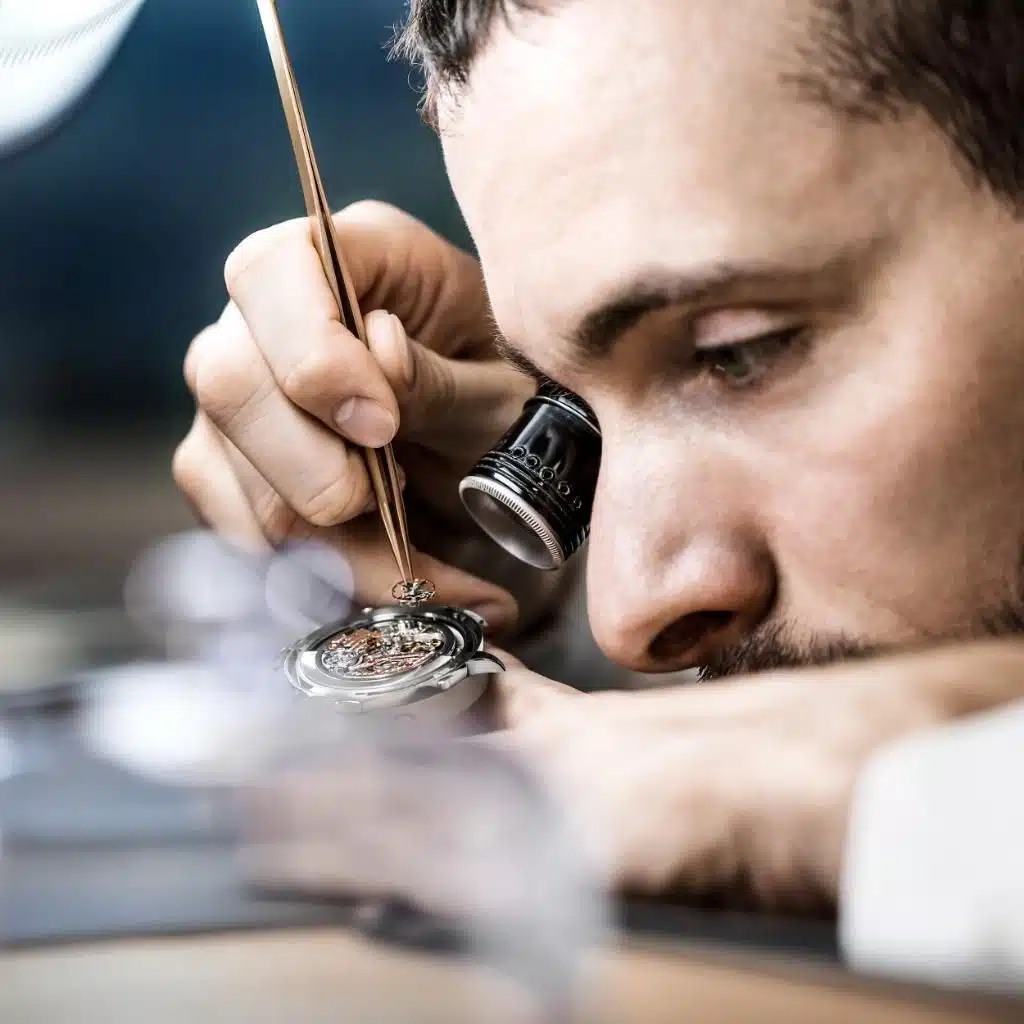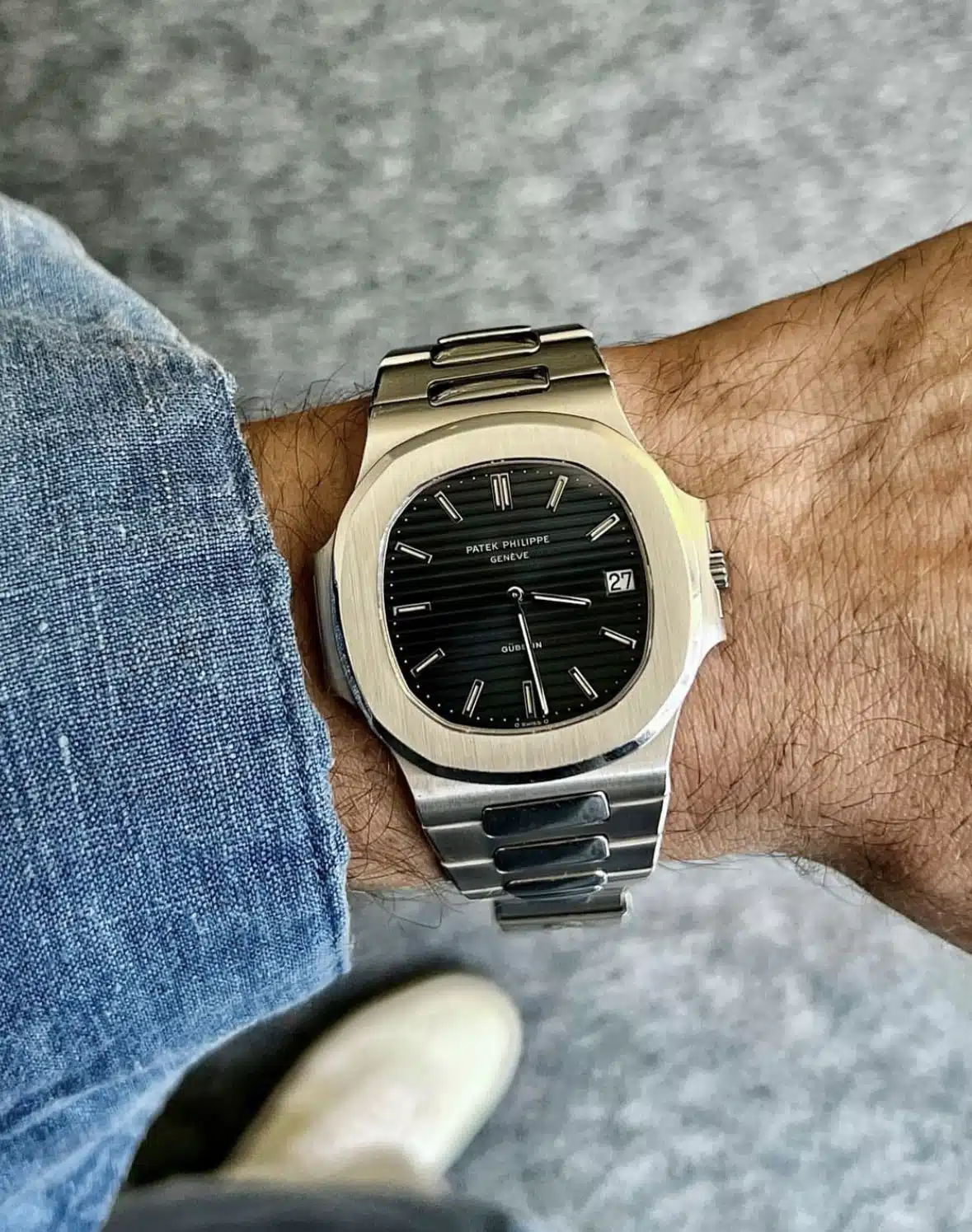Basic Watch Parts
- Movement: The inner mechanism that powers the watch.
- Case: The outer shell that holds the watch’s internals.
- Dial: The face of the watch, displaying the time.
- Hands: The moving parts that indicate hours, minutes, and sometimes seconds.
- Crown: A knob on the side of the watch used to set the time and wind the mainspring.
- Crystal: The clear cover over the dial, can be made of sapphire, mineral, or acrylic.
- Bezel: The ring around the dial; can have special functions.
- Lugs: The protrusions where the strap or bracelet attaches to the case.
- Bracelet: A metal link strap.
- Strap: A non-metal band made of leather, rubber, etc.
Movement Types
- Mechanical Movement: Powered by a wound spring, requires regular winding (manually or automatic).
- Automatic Movement: A mechanical movement that winds itself with the motion of the wearer’s wrist.
- Quartz Movement: Powered by a battery and a quartz crystal for accuracy.
- Manual Movement: A mechanical movement that needs manual winding.
- Solar-Powered: Uses solar cells to convert light into energy.
Complications
- Chronograph: A stopwatch function.
- Calendar: Shows the date, and often the day/week/month.
- Moon Phase: Displays the lunar phase.
- Dual Time: Shows time in two different time zones.
- Alarm: A feature that allows the watch to emit a sound at a set time.
- Tourbillon: A device in mechanical watches that reduces the effects of gravity on timekeeping.
- Perpetual Calendar: Automatically adjusts for months of different lengths and leap years.
- Minute Repeater: A watch that chimes the time when a lever is pressed.
- Power Reserve Indicator: Shows how much winding power is left.
- World Time: Indicates time in multiple zones around the world.
Watch Styles
- Dress Watch: Elegant, often simplistic style meant for formal occasions.
- Dive Watch: Designed for underwater diving, water-resistant.
- Pilot’s Watch: Features suited for aviation (often with a chronograph).
- Field Watch: Rugged, practical for outdoor activities.
- Racing Watch: Often includes a chronograph, sporty design.
- Smartwatch: A digital watch with computer capabilities and connectivity.
- Luxury Watch: High-end, often with premium materials and craftsmanship.
- Vintage Watch: An older watch, often sought after for collectibility.
- Skeleton Watch: A watch with a visible movement through the dial or back.
- Tactical Watch: Built for durability with features useful in military or outdoor situations.
Materials
- Stainless Steel: Common, durable material for cases and bracelets.
- Titanium: Lighter and stronger than steel, hypoallergenic.
- Gold: Used for luxury watches, available in different colors.
- Ceramic: Scratch-resistant, often used in bezels and cases.
- Platinum: Very precious metal, heavier and more durable than gold.
- Rubber: Used in sporty, water-resistant straps.
- Leather: Classic material for straps, varies in quality.
- Sapphire Glass: High scratch resistance, used for crystals.
- Mineral Glass: Less costly than sapphire, more scratch-resistant than acrylic.
- Acrylic: Plastic, less scratch-resistant, often found in vintage watches.
Functions & Features
- Water Resistance: Indicates how well a watch is sealed against water entry.
- Luminosity: Glow-in-the-dark feature for visibility in low light.
- Shock Resistance: Ability to withstand impacts.
- Rotating Bezel: A bezel that can be turned, usually for tracking elapsed time.
- Screw-down Crown: A crown that can be screwed into the case to improve water resistance.
- Helium Escape Valve: A feature in dive watches, allowing helium to escape during decompression.
- Tachymeter: A scale on the bezel for calculating speed.
- GMT Function: Allows tracking of a second time zone.
- PVD Coating: Physical Vapor Deposition, a method for coloring cases.
- Anti-Reflective Coating: Reduces glare on the crystal.
- Flyback Chronograph: A chronograph that can be reset without stopping.
- Split-Second Chronograph: Has two seconds hands for timing different events that start at the same time.
- Jewels: Synthetic rubies used in movements to reduce friction.
- Mainspring: The spring that powers mechanical movements.
- Escapement: Distributes the release of energy from the mainspring.
Watch Anatomy
- Subdial: Smaller dials on the main dial for additional information.
- Chapter Ring: A ring with minute markers around the edge of the dial.
- Rehaut: The ring between the dial and the crystal, sometimes bearing inscriptions.
- Fluted Bezel: A bezel design with grooves, often found in dress watches.
- Deployment Clasp: A folding buckle on a bracelet or strap.
- Buckle: The traditional pin-and-hole mechanism to secure a strap.
- Case Back: The backside of the watch; can be solid or see-through.
- Pusher: Button on the case to operate the chronograph or other functions.
- Balance Wheel: The part that oscillates to keep time in a mechanical watch.
- Spring Bar: A tiny bar used to attach the strap or bracelet to the lugs.
Terms of Craft
- Horology: The art and science of timekeeping and watchmaking.
- Engraving: Decorative carving on the case or movement.
- Guilloché: A decorative pattern, often engraved into the dial.
- In-house Movement: A movement developed and produced by the watch brand itself.
- Swiss Made: Watches made in Switzerland, meeting specific criteria.
- COSC Certification: A precision certificate from the Official Swiss Chronometer Testing Institute.
- Limited Edition: Watches produced in a specific, limited quantity.
- Patina: The aging effect on materials like the dial and strap, often valued for its aesthetic.
- Open Heart: A dial design where part of the movement is visible.
- Regulator: A watch that separates the hour and minute hands into different axes and dials.
Technical Terms
- Amplitude: The swing of the balance wheel, critical for accuracy.
- Frequency: Number of vibrations per hour of the movement, measured in hertz.
- Beat Rate: The number of beats per hour, affecting the smoothness of the second hand.
- Accuracy: How close a watch’s timekeeping is to the actual time.
- Isochronism: The ability of the watch to keep consistent time, irrespective of its power reserve.
- Chronometer: A watch with high precision, often certified.
- Hack or Hacking Seconds: A feature that stops the second hand while setting the time for precise synchronization.
- Oscillator: An element, typically a balance wheel with a hairspring, that regulates timekeeping.
- Winding: The action of adding energy to the mainspring, either manually or automatically.
Watch Maintenance
- Service: Regular maintenance to keep a watch functioning accurately.
- Overhaul: A comprehensive servicing that includes cleaning, oiling, and parts replacement.
- Polishing: The process of restoring the watch’s shine, can affect the value of vintage watches.
- Water Resistance Check: Ensuring the watch’s seal against water is intact.
- Regulation: Adjusting the watch to improve its accuracy.
- Refurbishment: Restoring a watch to improve its appearance and function.
Collecting & Purchasing
- Provenance: The history and ownership record of a watch.
- Box and Papers: The original packaging and documentation that come with the watch.
- Grey Market: A non-authorized dealer selling new watches, often at a discount.
- Aftermarket Parts: Non-original parts added or replaced in a watch.
- Pre-owned: Watches that have been previously owned, often available at lower prices than new ones.
As we conclude our horological journey through « Timepiece Terminology: 100 Essential Watch Terms Every Beginner Should Know, » it’s clear that the world of watches is as deep and nuanced as it is captivating. Each term we’ve explored opens up a new aspect of watchmaking – a blend of art, science, and engineering that has been perfected over centuries. Whether you find yourself enchanted by the mechanical wizardry of movements, the meticulous craftsmanship of cases, or the sheer diversity of styles and functions, the language of watches is your key to unlocking this rich and fascinating field.
Armed with these foundational terms, you’re now better equipped to delve deeper into the world of horology, appreciate the subtle nuances of different watches, and converse with fellow enthusiasts with greater confidence. Remember, every watch tells a story beyond just the time; it speaks of history, personal journeys, and the relentless pursuit of precision and beauty. So, whether you’re selecting your next watch, visiting a museum, or simply admiring a passing glance at someone’s wristwear, you’ll find that understanding the language of watches adds a deeper dimension of enjoyment and appreciation to this timeless passion.


